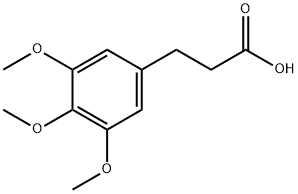3,4,5-Trimethoxyhydrozimtsure
CAS-Nr.
25173-72-2
Bezeichnung:
3,4,5-Trimethoxyhydrozimtsure
Englisch Name:
3-(3,4,5-TRIMETHOXYPHENYL)PROPIONIC ACID
Synonyma:
AKOS BBS-00006959;TIMTEC-BB SBB000794;LABOTEST-BB LT00233171;5-Trimethoxyphenyl)propanoic acid;3,4,5-TRIMETHOXYHYDROCINNAMIC ACID;3,4,5-Trimethoxyphenylpropionic acid;3,4,5-trimethoxydihydrocinnamic acid;3-(3,4,5-trimethoxyphenyl)propanoate;3,4,5-Trimethoxybenzenepropanoic acid;3,4,5-Trimethoxybenzenepropionic acid
CBNumber:
CB0283225
Summenformel:
C12H16O5
Molgewicht:
240.25
MOL-Datei:
25173-72-2.mol
3,4,5-Trimethoxyhydrozimtsure Eigenschaften
Schmelzpunkt:
100-104 °C (lit.)
Siedepunkt:
373℃
Dichte
1.169
Brechungsindex
1.5140 (estimate)
Flammpunkt:
140℃
storage temp.
Sealed in dry,Room Temperature
L?slichkeit
methanol: 0.1 g/mL, clear
pka
4.70±0.10(Predicted)
Aggregatzustand
Crystalline Powder
Farbe
White to almost white
BRN
1471912
InChIKey
ZCYXGVJUZBKJAI-UHFFFAOYSA-N
CAS Datenbank
25173-72-2(CAS DataBase Reference)
Sicherheit
Risiko- und Sicherheitserkl?rung
Gefahreninformationscode (GHS)
Bildanzeige (GHS)
Alarmwort
Warnung
Gefahrenhinweise
Code
Gefahrenhinweise
Gefahrenklasse
Abteilung
Alarmwort
Symbol
P-Code
H302 Gesundheitssch?dlich bei Verschlucken.
Akute Toxizit?t oral
Kategorie 4
Warnung
P264, P270, P301+P312, P330, P501
H315 Verursacht Hautreizungen.
Hautreizung
Kategorie 2
Warnung
P264, P280, P302+P352, P321,P332+P313, P362
H319 Verursacht schwere Augenreizung.
Schwere Augenreizung
Kategorie 2
Warnung
P264, P280, P305+P351+P338,P337+P313P
H335 Kann die Atemwege reizen.
Spezifische Zielorgan-Toxizit?t (einmalige Exposition)
Kategorie 3 (Atemwegsreizung)
Warnung
Sicherheit
P261 Einatmen von Staub vermeiden.
P305+P351+P338 BEI KONTAKT MIT DEN AUGEN: Einige Minuten lang behutsam mit Wasser spülen. Eventuell vorhandene Kontaktlinsen nach M?glichkeit entfernen. Weiter spülen.
3,4,5-Trimethoxyhydrozimtsure Chemische Eigenschaften,Einsatz,Produktion Methoden
R-S?tze Betriebsanweisung:
R36/37/38:Reizt die Augen, die Atmungsorgane und die Haut.
S-S?tze Betriebsanweisung:
S22:Staub nicht einatmen.
S24/25:Berührung mit den Augen und der Haut vermeiden.
Chemische Eigenschaften
WHITE TO ALMOST WHITE CRYSTALLINE POWDER
Definition
ChEBI: A monocarboxylic acid consisting of propionic acid having a 3,4,5-trimethoxyphenyl substituent at the 3-position.
3,4,5-Trimethoxyhydrozimtsure Upstream-Materialien And Downstream Produkte
Upstream-Materialien
Downstream Produkte
3,4,5-Trimethoxyhydrozimtsure Anbieter Lieferant Produzent Hersteller Vertrieb H?ndler.
Global( 107)Lieferanten
Belgium 2
China 65
Europe 1
Germany 4
India 2
Japan 1
Slovakia 1
Switzerland 3
Ukraine 2
United Kingdom 7
United States 18
USA 1
Global 107
25173-72-2(3,4,5-Trimethoxyhydrozimtsure)Verwandte Suche:
Ethyl-3-(3,4,5-trimethoxyphenyl)propionat
Ethyl-3-oxo-3-(3,4,5-trimethoxyphenyl)propionat
3,4,5-Trimethoxyhydrozimtsure
2-(2,3,4-Trimethoxyphenyl)propionsure
3-(2,4,6-Trimethoxyphenyl)propionsure
3-(2,3,4-Trimethoxyphenyl)propionsure
Diethyl-(3,4,5-trimethoxybenzoyl)malonat
TIMTEC-BB SBB000794
3,4,5-TRIMETHOXYHYDROCINNAMIC ACID
3-(3,4,5-TRIMETHOXYPHENYL)PROPANOIC ACID
3-(3,4,5-TRIMETHOXYPHENYL)PROPIONIC ACID
AKOS BBS-00006959
LABOTEST-BB LT00233171
BETA-(3,4,5-TRIMETHOXYPHENYL)PROPIONIC ACID
B-(3,4,5-TRIMETHOXYPHENYL)PROPIONIC ACID
3,4,5-Trimethoxyphenylpropionic acid
Benzenepropanoic acid, 3,4,5-trimethoxy-
3-(3,4,5-TRIMETHOXYPHENYL)PROPIONIC ACID , 98+%
3,4,5-trimethoxydihydrocinnamic acid
3,4,5-Trimethoxybenzenepropanoic acid
3,4,5-Trimethoxybenzenepropionic acid
3-(3,4,5-Trimethoxyphenyl)propionic acid ,99%
3,4,5-Trimethoxy-beta-phenylpropionic acid
me: 3-(3,4,5-TRIMETHOXYPHENYL)PROPIONIC ACID
3-(3,4,5-trimethoxyphenyl)propanoate
5-Trimethoxyphenyl)propanoic acid
3(3,4,5Trimethoxyphenyl)propanoic acid,Endogenous Metabolite,Inhibitor,3 (3,4,5 Trimethoxyphenyl)propanoic acid,inhibit
25173-72-2
15173-72-2
CH3O3C6H2CH2CH2CO2H
CARBOXYLIC ACID
Organic Building Blocks
Building Blocks
Carbonyl Compounds
Carboxylic Acids
C11 to C12
Aromatic Propionic Acids
API intermediates








